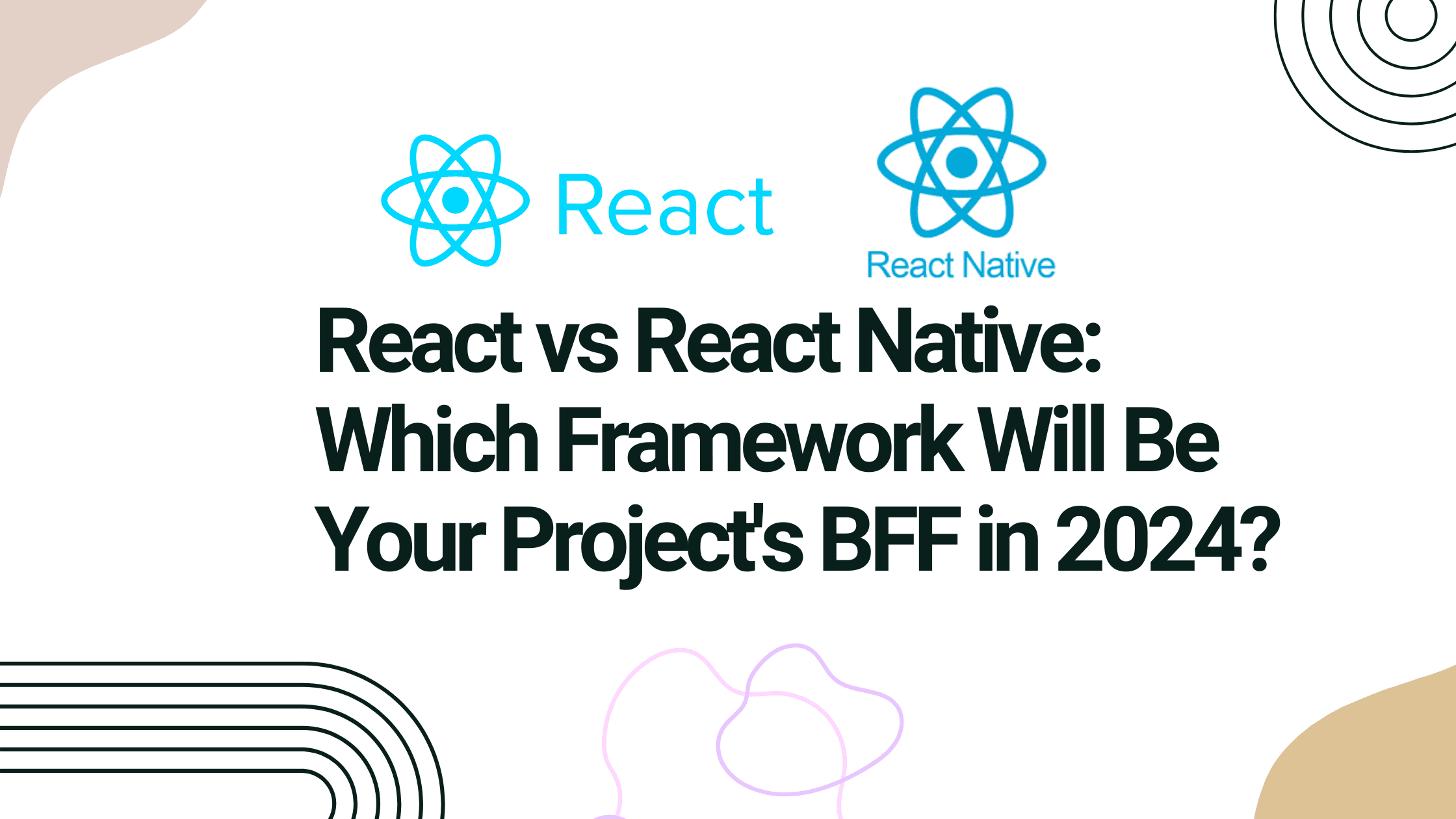React vs React Native: Which Framework Suits Your Project Best in 2024?
Developers face a significant decision point: selecting the ideal framework for their next project. The choice between React and React Native isn’t always clear cut. Both frameworks carry the React name and originate from Meta (formerly Facebook), yet they serve different purposes in the development ecosystem.
Many developers ask us about React versus React Native differences as they begin new projects. React shines in web development through its virtual DOM and component-based architecture. React Native, on the other hand, specializes in mobile app development with native components. Your project’s success in 2024 depends on understanding these fundamental differences. This detailed walkthrough will guide you through each framework’s strengths, limitations, and use cases to help you make an informed choice.
Understanding the Core Differences
Let’s explore the key differences between React and React Native to see what makes these technologies unique. We’ll get into their architecture, development needs, and performance characteristics.
Architecture and Technology Stack
React and React Native’s architecture shows two different ways to build applications. React focuses on web development and uses HTML, CSS, and JavaScript to create interactive user interfaces 1. React Native works differently – it connects JavaScript with native components to build true native mobile apps 2.
Here’s how their core architectures stack up:
| Feature | React | React Native |
|---|---|---|
| UI Elements | HTML & CSS | Native Components |
| Rendering Engine | Virtual DOM | Native APIs |
| Platform Focus | Web Browsers | iOS & Android |
| Component Structure | Web Components | Platform-Specific Components |
Development Environment Requirements
The development setup looks quite different between these frameworks. React works in a web development ecosystem 3. React Native needs a more detailed mobile development environment.
Key development requirements include:
- React Native needs mobile SDKs and platform-specific emulators/simulators 3
- Both frameworks use Chrome DevTools to debug 1
- React Native has a built-in animation library and CSS-in-JS styling system 4
Performance Characteristics
Each framework takes its own approach to optimization. React’s virtual DOM handles UI updates efficiently for web applications 2. React Native uses a dual-thread architecture:
React Native’s performance model works through:
- A JavaScript thread handles calculations and logic 2
- A Native thread takes care of UI component rendering 2
- An asynchronous bridge manages communication between layers 2
React Native’s architecture keeps getting better. New features like JSI (JavaScript Interface) remove the need for bridge-based communication 2. This change allows JavaScript and native code to talk directly, which makes everything run faster.
Each framework shines in its own way. React excels at web performance with its virtual DOM implementation 3. React Native delivers speed close to native apps by using platform-specific UI components 3. Your choice depends on whether you want to build for web or mobile platforms.
Project Requirements Analysis
Picking the right framework between React and React Native depends on your project needs. Our analysis shows that an early decision can affect development success by a lot.
Target Platform Considerations
Platform selection shapes our framework choice. React Native lets developers build for multiple platforms at once. About 38% of developers pick it specifically to create mobile apps 5. This cross-platform feature helps us:
- Use identical logic layer for both Android and iOS platforms 5
- Create platform-specific code automatically 5
- Set up native module systems for direct API rendering 5
User Experience Expectations
User experience needs are vital in framework selection. React Native helps create a native app-like feel through direct API rendering 5. This matters especially when you have:
- Platform-specific UI components that match native applications 3
- Ready-to-use UI libraries to create engaging user experiences 5
- Native code integration options to optimize performance 4
Development Timeline and Budget
Timeline and budget limits shape our framework choice. React Native projects usually cost between $15,000 to $300,000 6. Several factors affect the final investment:
| Cost Component | Description |
|---|---|
| Development | Main expense including time and expertise 6 |
| Design | UI/UX implementation costs 6 |
| Testing | Quality assurance and validation 6 |
| Deployment | Post-development expenses 6 |
React Native can speed up development through features like:
- Hot reloading for quick code updates 5
- Code you can reuse across platforms 5
- Component-based architecture for flexible development 5
Budget planning works best with clear scope and feature priorities 6. This helps keep costs down without cutting corners on quality. Remember that third-party library fees and complex integrations might add hidden costs 6.
Development Team Capabilities
Our work with both frameworks shows that a team’s skills directly affect how well a framework works. Let’s look at what makes a successful development team for React or React Native projects.
Required Skill Sets
Building development teams needs a solid JavaScript foundation for both frameworks. React Native developers should be skilled in these areas:
- Core JavaScript expertise with ES6+ features 7
- Understanding of native iOS and Android development principles 7
- Proficiency in state management and API integration 8
- Experience with performance optimization and debugging 8
Learning Curve Assessment
The learning path differs between these two frameworks. React provides an easier learning curve for web developers because of its simple component-based architecture 3. Our work reveals that:
- React developers who know JavaScript well adapt more easily 3
- React Native needs extra knowledge of mobile development concepts 3
- The framework’s pre-built components help speed up learning 9
Team Size and Structure
Team makeup is vital to successful framework adoption. A typical React Native team structure has:
| Role | Typical Distribution |
|---|---|
| iOS Developers | 3-4 members 10 |
| Android Developers | 2-3 members 10 |
| Project Manager | 1 member 10 |
| Designer | 1 member 10 |
The team’s comfort with JavaScript makes a big difference in project success. A case study showed three out of four iOS developers reached good to high comfort levels with JavaScript and React Native 10. Android developers showed different levels of adaptation to the JavaScript ecosystem.
These steps lead to better team performance:
- Keep a balanced mix of platform-specific expertise
- Promote strong communication between team members 7
- Support continuous learning and specialization 7
React Native’s “write once, use everywhere” approach helps streamline processes 11, especially when team members understand both JavaScript and mobile development concepts well.
Business Impact Factors
Business decisions need careful evaluation of financial aspects and market timing. Our analysis of React versus React Native reveals several vital factors that affect business outcomes.
Time to Market Considerations
React Native offers substantial advantages for quick deployment. Our research shows it can cut development time in half compared to traditional native development 12. These efficiency gains come from:
- Single codebase development for multiple platforms 3
- Hot reloading feature for immediate change visualization 3
- Over-the-air updates reducing deployment delays 3
Maintenance and Scalability
Our hands-on experience with both frameworks shows varying maintenance needs. React Native stands out with these scalability benefits:
- Simple bug fixes across platforms 13
- Better update capabilities 13
- Simplified processes that cut overhead 12
React Native’s maintenance process works better because fixing issues on one platform usually fixes them everywhere 13. This unified approach cuts down the maintenance work compared to managing separate codebases.
Cost-Benefit Analysis
Our financial review shows clear cost advantages with React Native. Here’s a breakdown of the cost effects:
| Cost Factor | Impact |
|---|---|
| Original Development | 30-35% reduction in development costs 13 |
| Annual Maintenance | Five-figure savings per year 12 |
| Team Structure | Reduced overhead from shared codebase 12 |
| Long-term ROI | Significant savings in six figures 12 |
React Native’s cost savings come from:
- Less duplicate work through code sharing 12
- Faster development that cuts costs 12
- Simple maintenance that reduces ongoing expenses 12
The financial benefits stand out with original development savings reaching six figures 12. On top of that, yearly maintenance costs drop by five figures through simplified processes and smaller staff needs 12.
Companies with tight budgets or deadlines find React Native an affordable path to market 14. The framework keeps high performance while cutting development overhead, making it ideal for quick multi-platform deployments 15.
2024 Market Trends
The web and mobile development frameworks landscape in 2024 shows fascinating changes in how developers adopt React and React Native. A complete analysis reveals trends that shape both frameworks’ future.
Framework Popularity and Growth
React Native’s adoption has gained momentum, especially in mobile development. Stack Overflow survey data shows React Native holds a strong 9.14% adoption rate among professional developers 16. Repository metrics reveal impressive growth:
| Metric | React Native | Growth Trend |
|---|---|---|
| GitHub Repository Results | 520,000 | Increased from 355,832 in early 2023 16 |
| Monthly npm Downloads | 50 million | Exceeding previous years 17 |
| Job Market Demand | High | Leading in mobile development positions 17 |
Community Support and Resources
React Native’s reliable ecosystem has matured substantially. The numbers tell an impressive story:
- More than 850 libraries now compatible with the New Architecture 18
- All libraries with over 200K weekly downloads supporting the latest features 18
- Complete documentation and community-driven solutions 4
Future Development Roadmap
React Native’s architecture has improved substantially. The latest release (0.76) brings game-changing updates:
- Full support for modern React features, including:
- Suspense and Transitions
- Automatic batching
- Advanced useLayoutEffect implementation 18
The New Architecture alters React Native’s core systems completely 18, adding:
- Better JavaScript-native platform communication
- Advanced multi-threaded work scheduling
- Sophisticated rendering capabilities across different priority levels 18
Major applications like Facebook, Instagram, and Expensify already exploit the New Architecture in production 18. This real-world validation proves the framework’s stability and future potential.
The road ahead shows greater focus on cross-platform developer experience. TypeScript integration and layout management improvements take center stage 16. These advances demonstrate React Native’s steadfast dedication to staying competitive in the mobile development world.
Real-World Success Stories
Real-life implementations show how React and React Native have changed digital experiences in many industries. The success stories of these frameworks tell a compelling tale of their practical effects.
React Success Cases
React has completely changed how users experience web applications. Airbnb saw a soaring win with React that led to faster site loading and better performance 19. Netflix used React to boost their startup speed and runtime performance while making their platform more modular 19.
WhatsApp’s web application stands out as a great example. Their React implementation matched their mobile application’s performance 19. The New York Times caught everyone’s attention when they used React to speed up their digital platform’s loading times and user involvement 19.
React Native Success Cases
React Native’s mobile development capabilities shine through several impressive implementations. Here are the key numbers we found:
- Facebook Ads Manager delivered smooth cross-platform performance that handled complex ad formats and currencies 20
- Instagram used 85-90% of the same code for iOS and Android platforms 20
- Walmart shared 95% of code between platforms 20
- Bloomberg built their app in just five months 20
Discord achieved amazing results by sharing 98% of code between iOS and Android platforms 21. These implementations led to huge cost savings and faster development cycles.
Hybrid Implementation Examples
Organizations that use both frameworks effectively tell fascinating stories. Here’s a comparison table of notable hybrid implementations:
| Company | Implementation | Results |
|---|---|---|
| Combined web/mobile approach | 2x faster performance 20 | |
| Push notification integration | Enhanced user engagement 20 | |
| Uber Eats | Dashboard implementation | Improved UI/UX metrics 21 |
The versatility of both frameworks really shines in hybrid implementations. A great example shows React Native screens blending into native platforms, with smooth communication between React Native and native components 22.
A Japanese railway network booking system tells another interesting story 23. They combined web development with business process support and saw increased sales and better user experience 23.
Hybrid implementations often give clients the best results. Memcare rewrote their entire application in two months, showing how modern design principles work across platforms 23. SnowShow’s booking system achieved a 70% increase in digital sales by using smart architecture and machine learning 23.
These success stories prove that React and React Native can help achieve business goals while keeping performance high and users happy.
Comparison Table
| Feature | React | React Native |
|---|---|---|
| Main Goal | Web development | Mobile app development |
| UI Elements | HTML & CSS | Native Components |
| Rendering Engine | Virtual DOM | Native APIs |
| Platform Focus | Web Browsers | iOS & Android |
| Component Structure | Web Components | Platform-Specific Components |
| Development Environment | Web development ecosystem | Mobile SDKs and platform-specific emulators/simulators |
| Performance Model | Virtual DOM for UI updates | Dual-thread architecture (JavaScript + Native) |
| Debugging Tools | Chrome DevTools | Chrome DevTools |
| Learning Curve | Easier to learn, especially for web developers | More challenging, needs mobile development expertise |
| Development Cost Range | Not mentioned | $15,000 to $300,000 |
| Code Reusability | Web-only | Up to 98% between iOS and Android |
| Key Benefits | – Quick web performance – Straightforward component architecture – Robust web ecosystem | – Cross-platform development – Native-like performance – Hot reloading feature – Over-the-air updates |
| Major Users | – Airbnb – Netflix – WhatsApp Web – New York Times | – Facebook Ads Manager – Walmart – Bloomberg |
Conclusion
React and React Native shine in different ways and bring their own advantages to specific development needs. React rules web development with its virtual DOM and component-based architecture. React Native excels at cross-platform mobile apps that perform almost like native ones.
The market in 2024 looks great for both frameworks. React Native has become especially popular with big names like Facebook, Instagram, and Walmart jumping on board. Real-world success stories tell an impressive tale. WhatsApp built a high-performance web app with React. Discord achieved 98% code sharing between mobile platforms using React Native.
Money matters make React Native an attractive choice for cross-platform projects. Companies can save hundreds of thousands in development costs. Team skills are a vital factor though. Web developers find React easier to pick up, but React Native needs extra mobile development know-how.
In a nutshell, React works best for web-focused projects. It delivers top performance and makes maintenance easier. React Native is perfect for businesses that want to reach mobile users on different platforms. It saves money through code reuse. Your choice between these frameworks depends on your project’s needs, your team’s expertise, and which platforms matter most to you.
FAQs
What are the main differences between React and React Native?
React is designed for creating web applications using HTML and CSS components, while React Native is tailored for developing mobile applications with components that align with native iOS and Android elements.
As of 2024, which is more advantageous, Flutter or React Native?
Flutter excels in rendering performance and CPU efficiency, whereas React Native is superior in terms of memory management and offers a more authentic native application experience. Each framework has its unique strengths depending on the performance needs.
How do Next.js, React, and React Native differ in their applications?
Next.js is optimal for constructing dynamic websites and is continually evolving with a focus on innovation and community support. React Native, however, is preferred for cross-platform mobile app development, leveraging its robust capabilities in this area.
What does the future hold for React Native?
The future of React Native looks promising with advancements in integrating machine learning technologies. These enhancements are set to enrich user experiences by enabling features like personalized content and predictive analytics.
https://arcdev.in/how-to-set-up-react-native-on-ubuntu-a-comprehensive-guide/
References
[1] – https://www.freecodecamp.org/news/react-js-vs-react-native-whats-the-difference/
[2] – https://stackoverflow.com/questions/34641582/what-is-the-difference-between-react-native-and-react
[3] – https://www.matellio.com/blog/react-vs-react-native/
[4] – https://brainhub.eu/library/react-vs-react-native
[5] – https://www.moontechnolabs.com/blog/reactjs-vs-react-native/
[6] – https://www.techaheadcorp.com/blog/how-much-do-react-native-development-projects-cost/
[7] – https://www.netguru.com/blog/react-native-developer-skills
[8] – https://www.adaface.com/blog/skills-required-for-react-native-developer/
[9] – https://www.expertappdevs.com/blog/reactjs-vs-react-native
[10] – https://engineering.udacity.com/react-native-a-retrospective-from-the-mobile-engineering-team-at-udacity-89975d6a8102
[11] – https://redstaglabs.com/blog/react-vs-reactnative-a-detailed-comparison-of-capabilities-and-performance
[12] – https://www.mobiloud.com/blog/react-native-vs-native-development
[13] – https://appinventiv.com/blog/react-native-vs-native-apps/
[14] – https://www.agicent.com/blog/react-vs-react-native/
[15] – https://www.conceptatech.com/blog/why-you-should-or-shouldnt-use-react-native
[16] – https://www.nomtek.com/blog/flutter-vs-react-native
[17] – https://www.monarch-innovation.com/react-native-vs-react-js
[18] – https://reactnative.dev/blog/2024/10/23/the-new-architecture-is-here
[19] – https://www.cronj.com/blog/exploring-reactjs-development-case-studies-success-stories/
[20] – https://www.uplers.com/blog/react-native-app/
[21] – https://trio.dev/companies-use-react-native/
[22] – https://github.com/tomoima525/react-native-hybrid-app
[23] – https://www.ideamotive.co/react/case-study





